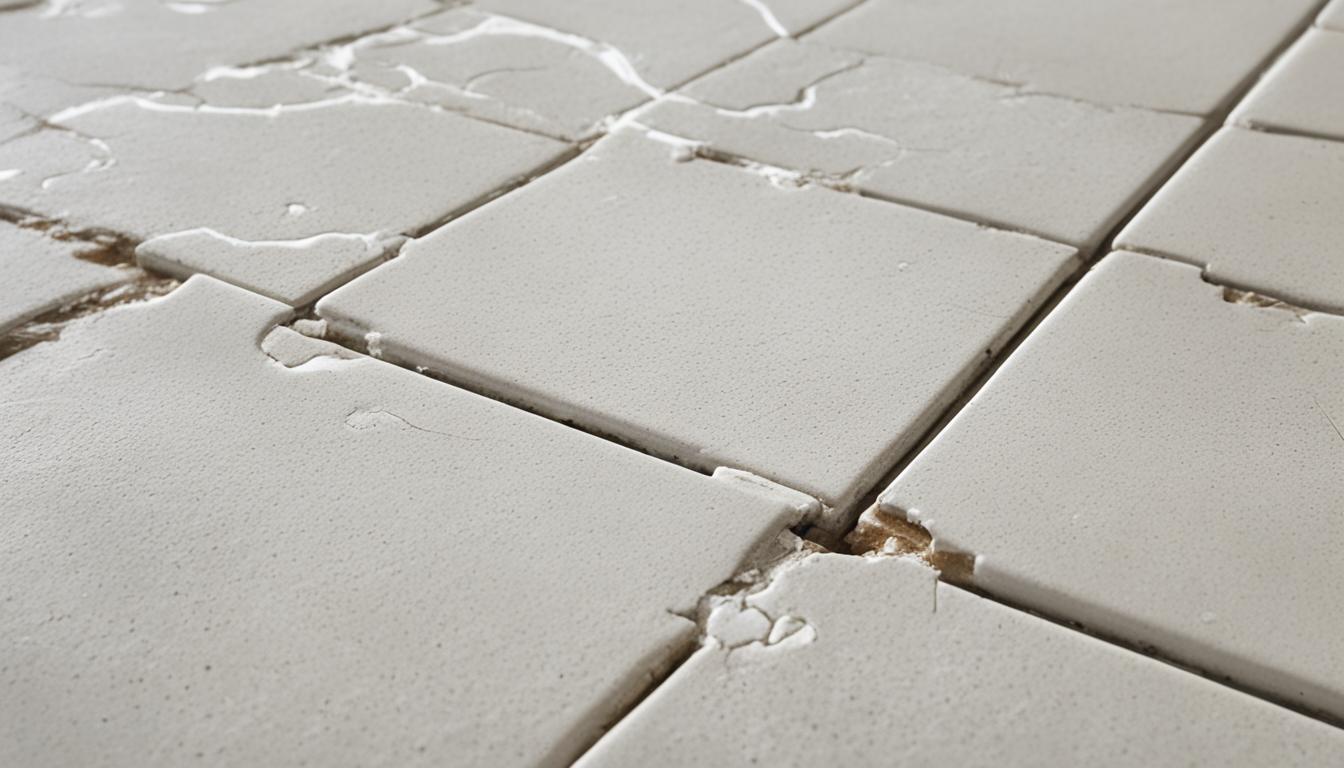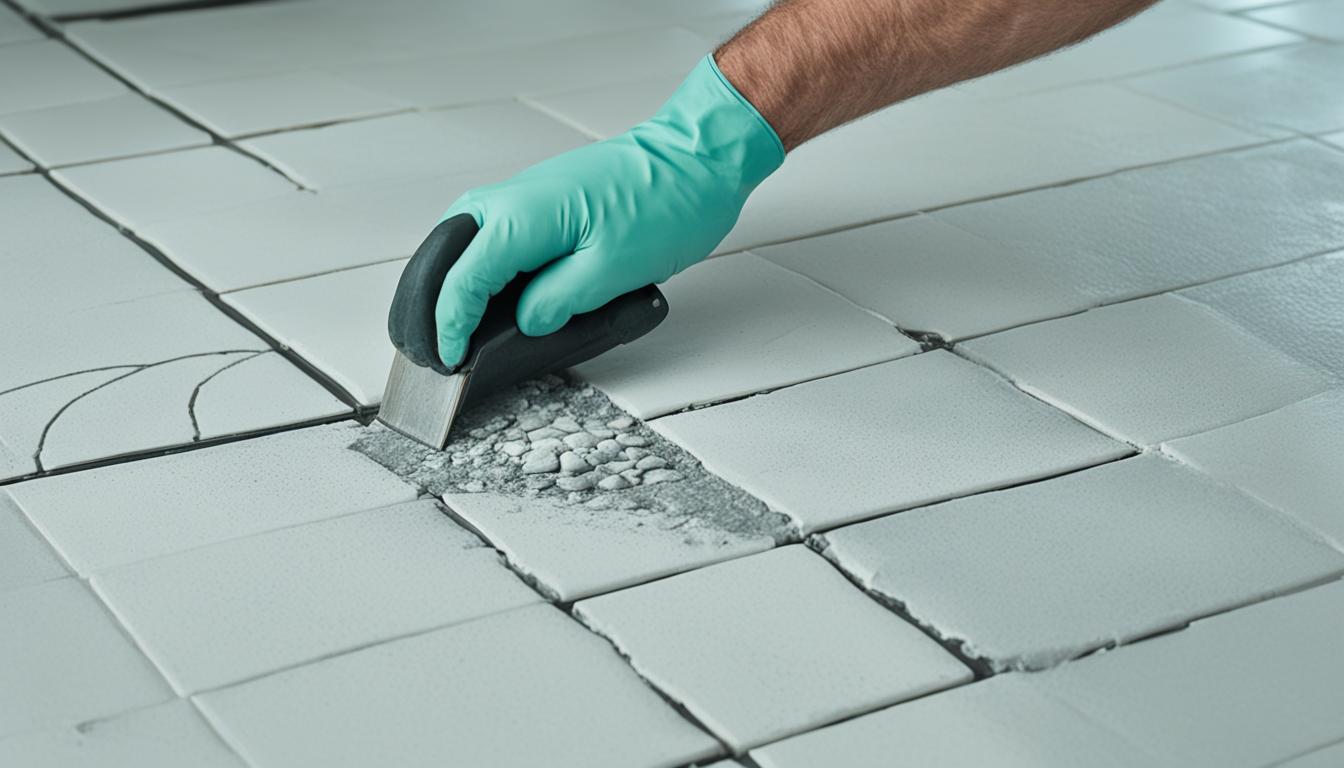When to Regrout Tile: Signs It's Time for a Refresh
Posted by Mike Belk on Aug 04, 2024

Ever wonder why your once-pristine tile floor now looks dingy and neglected? Could it be time to regrout? While cracked tiles or obvious damage are clear signs, the subtle signs your grout sends might surprise you. Knowing when to regrout can save you from expensive repairs and keep your home looking great.

Tile and grout are key to your kitchen and bathroom's look and function. But, they need regular care to stop mold and keep your home safe. Grouted tile can last 15 to 20 years with the right care. But, how do you know when it's time for a refresh?
Experts like Grout Specialists in Denver say it's vital to watch for signs that show you need to regrout. Signs like mold, discoloration, loose tiles, and damaged grout mean it's time to act. Knowing these signs can help you decide if you should call a pro or try it yourself.
Key Takeaways
- Recognizing subtle signs of grout deterioration can prevent costly repairs.
- Persistent mold and discoloration are key indicators that regrouting may be necessary.
- Bathrooms and showers are more susceptible to grout damage due to high moisture levels.
- Professional services, like Grout Specialists, can ensure a thorough and long-lasting regrouting job.
- Properly installed and maintained grout should last between 15 to 20 years.
- Loose or wiggling tiles can be a safety hazard and often require professional attention.
Introduction to Tile Regrouting
Grout is key to both the look and durability of tiles. Yet, it can become unsightly when it starts to deteriorate. Reasons to regrout tiles include discoloration, cracking, and crumbling. Dull or discolored grout means it has lost its original color. Cracked grout might point to subfloor damage from missing grout.
These issues are common reasons to regrout and tackle preventing tile grout deterioration.
Loose or missing grout can show problems with installation and upkeep. Homeowners often ask how often regrout tile areas. Should they refresh grout or replace the tiles? Refreshing grout can greatly improve the look and extend the life of tiled areas, enhancing home aesthetics.
Here's a look at the typical steps in regrouting:
- Plan on spending about two hours to remove the existing grout on a 16-square-foot section, plus an additional one to two hours to apply new grout.
- Standard powdered grout should be sealed for stain-resistance after it has fully cured.
- Unsanded grouts are suitable for joints that are 1/4-inch wide or less, while sanded grouts work best for wider grout lines.
- Regrouting tools like oscillating multitools and grout removal blades can range in cost from $80 to $200 or more, and are also available for rent.
Regrouting is a practical and cost-effective way to keep your tiles looking great. By preventing tile grout deterioration with the right techniques and tools, you'll make your tiled spaces look better for longer.
In summary, knowing how often regrout tile and following a preventive maintenance schedule will keep your grout in top shape. This ensures your home looks pristine and well-maintained for years.
Common Signs Your Tile Needs Regrouting
Knowing when to regrout your tiles is key for a clean and nice-looking surface. Grout can start to discolor after 12 years, often because of dirt, age, or wrong cleaning methods. This discoloration means it's time to regrout.
Mold and mildew in shower grout are not just ugly but can be harmful to health. In moist areas like shower stalls, mold often grows, showing it's time to regrout. Moisture behind tiles can make mildew and mold worse, proving the need for regrouting.
Cracked or crumbling grout is another sign you need to regrout. When grout gets bad, it can make tiles unstable, leading to loose or moving tiles. Seeing loose tiles, especially in busy areas like showers, means it's time to regrout.
Experts say grout should be replaced every 15 years as it wears out and stops working well. For those selling their house, regrouting before listing can boost the home's value. Fixing these signs early can stop big damage and keep your tiles safe and strong.
Discoloration from Mold and Mildew
Seeing mold and mildew in your grout means it's time to act. Knowing why mold grows and how to clean it can keep your tiles looking great. It also keeps them working well.
Causes of Mold and Mildew in Grout
Grout is porous, so it absorbs moisture easily. This can lead to mold, especially in places like showers and sinks. Mold loves warm, humid spots, making bathrooms and kitchens perfect for it. The pH level of grout also helps mold grow.
Grout lets water in, which is perfect for mold. Soft water can make pink mold grow on grout because it lacks minerals. Black and pink mold can show up as spots or stains on the grout lines.
Steps to Clean Mold and Prevent Recurrence
To stop mold in grout, start with cleaning and upkeep. Use special products to clean grout lines and remove discoloration. If mold doesn't go away, seal the grout to stop more mold. You'll need to reseal it from time to time to keep it working.
Here are some tips for regrouting:
- Remove old grout with the right tools before putting in new.
- Choose a grout mix with latex for better durability in wet places.
- Seal the grout after it's dry to protect it from stains and wear.
- Check grout often for damage or discoloration to know when to regrout.
- For big mold problems, think about hiring professionals for the best results.
Dealing with mold in grout quickly and right is key to keeping your tiles looking good. Remember, regular cleaning and regrouting when needed are key to stopping mold and keeping your tiles in top shape.
Cracked or Crumbling Grout
Grout damage, like cracking and crumbling, can really hurt the tile's strength. This damage often comes from too much force, aging, or being constantly wet. Spotting the signs of needing regrouting early is key to keeping your tiles looking good and lasting long.
Impact of Damaged Grout on Tile Integrity
When grout cracks or crumbles, it weakens the tile. This can let moisture in, which leads to mold and makes the tile adhesive weaker. So, watching for signs of needing regrouting is crucial to stop big problems with the tiles and the floor underneath.
Grout damage can show up in many ways, like cracks in shower corners or joints that didn't cure right. To keep tile integrity strong, fixing these problems quickly is a must. Using sealant often can also help keep grout lines strong and prevent cracks.
Repairing and Replacing Damaged Grout
To fix and replace damaged grout, start by removing it with a grout saw. You might need to clean the area well, using a mix of vinegar and water. Always wear eye protection when removing grout to avoid getting hurt by debris.
- Fill joints with the right grout type—sanded or unsanded, depending on the joint size and tile type.
- Clean off extra grout with a damp sponge for a smooth look.
- Use flexible silicone caulking in corner joints to stop them from cracking later.
There are many kinds of grout, each with its own traits:
| Grout Type | Characteristics | Best Used For |
|---|---|---|
| Acrylic Latex | Easy to work with but needs sealing. | General use, except in wet areas. |
| Epoxy | Stain-resistant, doesn't need sealing, but hard to apply. | Areas that get a lot of moisture like showers. |
| Sanded | Good for joints wider than 1/8 inch, not for metal, glass, or marble tiles. | Big tile joints, ceramic tiles. |
| Unsanded | Great for joints 1/8 inch or less, perfect for delicate surfaces. | Small tile joints, metal, glass, and marble tiles. |
Figuring out how often to regrout tile depends on many things, like the grout type and the area's conditions. Regular checks by experts can tell you the best time to regrout. This keeps your tiling safe and looking good for a long time.
When to Regrout Tile
Deciding when to regrout tile depends on several factors. If cleaning doesn't make your tiles look good anymore, it's time to think about regrouting. Tiles with yellowing, stains, or discolorations will look better and be safer with new grout.
Check if your grout is cracked or crumbling. This can make tiles unstable and unsafe. If so, you might need to do it yourself regrouting steps or get professional help.
Regrouting is cheaper than replacing tiles. Using quality grout and sealant helps your tiles last longer. You might need to regrout every 8-10 years, depending on how much you use the area and the environment.
Wait 24-48 hours for the new grout to harden before using the area. Experts say removing old grout by hand or with tools is best. This prevents new grout from not setting right.
| Method | Cost Efficiency | Time Investment | Effectiveness |
|---|---|---|---|
| Regular Cleaning | High | Low | Moderate |
| Regrouting | Moderate | Moderate | High |
| Tile Replacement | Low | High | High |
Loose or Wiggling Tiles
Loose or wiggling tiles can mean several problems, like bad installation or old adhesive failure. These issues not only ruin the look but can also make floors and walls unstable. It's important to fix these problems quickly to keep your home safe.
One big problem is when the adhesive used to install tiles fails. For instance, 2x2 inch tiles that are dot-mounted on sheets without a mesh backing often lose their grip. Using a 1/4 x 1/4 square notch trowel for applying adhesive is common. But, it's key to wait about three days before walking on them for the adhesive to set right.
Yet, over time, adhesives can weaken from moisture, temperature changes, and aging. This can make floor tiles unstable and loose.

Also, problems with the subfloor, like settling or not matching materials, can cause tiles to move. If tiles sound hollow on foam shower pans, it means they weren't installed well. This is a good time to regrout your shower to stop future problems.
For fixing loose tiles, it's best to get professional help. They can reattach tiles with adhesives or fillers and grout. Epoxy injection under the tiles is a strong fix but might cost more. Sometimes, you need to remove uneven tiles and fix the underlying problems.
To stop grout issues and keep tiles in place, clean the old grout, put in new grout, and seal it. You can also use special adhesives, repair kits, and floor repair kits for small fixes without taking out all the tiles.
Quick action with professional regrouting services keeps your tiles secure and your home safe. It's a good idea to regrout shower areas and other tiled spots in your home now.
DIY Regrouting Steps
Regrouting your tiles can make them look new again. It's a great way to fix issues like mold stains, cracked grout, or loose tiles. By following these diy regrouting steps, you can do it yourself and save money. Here's a detailed guide to help you get professional-looking results.
Preparing Your Tile Surface
Start by cleaning the area well and removing any items that might get in the way. Use a household cleaner or a mix of water and detergent to clean the tiles. This makes sure the grout sticks well.
- Clear the area to avoid any damage.
- Pick a grout color that matches your tile.
- Check for damaged or old grout to make your tiles last longer.
Removing Old Grout
Getting rid of old grout is key for a good result. Use a grout saw or a utility knife to carefully remove the old grout.
- Old grout might need more work and time.
- Make sure to remove all loose or crumbling grout to stop future problems.
Applying New Grout
Mix the grout as the instructions say. Spread the mixture over the tiles with a grout float at a 30-degree angle. This fills the joints evenly.
- Think about using modified grout with latex for extra water resistance, like in bathrooms.
- Wait 12 to 24 hours before using the area again after applying grout.
Cleaning and Sealing New Grout
Clean off any extra grout from the tiles with a damp sponge. Once the grout is dry, seal it to protect it from moisture and stains. This keeps your tiles looking good for a long time.
- Sealing the grout helps it last longer.
- Keep up with maintenance, including resealing, to make the grout last.
By following these diy regrouting steps, you can save money and refresh your tiles. But for big projects or tricky tile patterns, it might be smart to get a regrouting cost estimate from experts. Always use the best tips and practices for the best results.
Key Takeaways:
- DIY regrouting can save you money, costing between $500 to $2000 for a bathroom or shower.
- Let the grout dry properly and use the right materials for a durable finish.
- Checking and maintaining your grout regularly stops it from getting worse and makes your tiles last longer.
Professional Regrouting Services
Keeping your tile installations looking great is key for both looks and function. Grout wears out over time, though. For this, getting professional regrouting services is a smart move. Companies like Sir Grout and D'Sapone® use top materials and methods for lasting results.
Quality grout can last 10 to 15 years if done right. But, cheaper grout might need more work sooner. Sir Grout, known by Entrepreneur Magazine as a top franchise, is a go-to for many in the US.
Choosing professional regrouting means getting expert advice at home or work. This makes the project quick and easy on your schedule. Sir Grout and D'Sapone® use new epoxy-resin sealers to keep moisture and mold out, making your grout last longer than usual.
There are many perks to hiring pros for regrouting. Sir Grout and D'Sapone® offer excellent service with top products and methods. D'Sapone® even gives a 5-year labor warranty, showing their dedication to quality and customer happiness.
Modern repair methods, like using special resin for cracked grout, fix problems for good. New grout sealers also stop mold and mildew in their tracks. Going with professional regrouting means your grout will look great and last longer, as detailed in cost estimates from these top companies.
In short, picking professional regrouting from Sir Grout and D'Sapone® keeps your tiles looking new for years. They use the latest in sealing products and methods for great results. This makes the cost of regrouting worth it.
Cost Estimates for Regrouting
Understanding the regrouting cost estimate is key before you start. The cost to regrout tile can be between $14.31 and $31.34 per square foot as of April 2024. We'll look at what affects these costs and how to plan your budget well.

Budgeting for Your Regrouting Project
When budgeting for regrouting, keep these estimates in mind:
| Type of Area | Cost range (per Sq Ft) | Total Cost Range |
| Tile Floor | $5 - $11 | $100 - $700+ |
| Tile Shower or Bathroom | $7 - $28 | $700 - $5,600 |
| Kitchen Backsplash (30 sq ft) | $ 5 - $13.33 | $150 - $400 |
| Living Room Floor (200 - 300 sq ft) | $3.33 - $11 | $1,000 - $3,300 |
| Patio | $1.77 - $11 | $230 - $3,300 |
Make sure to include all costs in your budget. For big projects, setting aside money for expert services and quality materials helps avoid future repairs. This can save you money over time.
Preventing Tile Grout Deterioration
To keep your tiles looking great and lasting long, focus on preventing grout from getting worse. Taking good care and regular maintenance can make your grout look new and work well for a long time. Let's look at some important steps.
Regular Maintenance Tips
Regular care for grout can really help avoid deterioration. Here are some key tips:
- Frequent Cleaning: Clean grout lines often to stop mold, mildew, and dirt from building up. Use a cleaner that's pH-neutral for the best effect.
- Dry Surfaces: Make sure tiled areas are dry after use, especially in bathrooms and kitchens. This helps avoid moisture damage.
- Spot Repairs: Fix small cracks or holes right away to stop them from getting bigger. This keeps your grout in great shape.
- Avoid Harsh Chemicals: Don't use harsh cleaners that can wear away grout over time. Choose gentle, special cleaners for grout instead.
Products to Enhance Grout Longevity
The right products are key to keeping grout strong. Here are some options:
- Grout Sealers: Sealing grout once a year is a simple way to protect it from moisture and stains. Aerosol sealers are affordable and easy to apply.
- Grout Cleaners: Use cleaners made just for grout that clean deeply without harming it. Using these products often can stop discoloration and buildup.
- Grout Additives: Adding special additives to the grout mix can make it more durable and less porous. These additives help prevent grout from deteriorating.
By following these tips and using the right products, you can make your tiles last longer. This means you won't have to regrout as often.
Best Time to Regrout Showers and Bathrooms
Regrouting your shower and bathroom tiles is key for looks and home safety. The best time to regrout shower and bathroom tiles is when you see mold, grout color changes, or the grout is old, about 15-20 years.
Showers need more frequent regrouting because they're wet. Seeing mold or mildew between tiles means it's time for new grout. Clean with a lemon and vinegar mix to kill mold before you start. Use grout saws to remove old grout for a clean base.
Here's when you should regrout:
| Indicators | Actions Needed |
|---|---|
| Mold/Mildew Growth | Thorough Cleaning, Regrouting |
| Grout Discoloration | Remove Old Grout, Apply New Grout |
| Visible Cracks | Replace Cracked Grout, Seal New Grout |
| Loose Tiles | Fix Tiles, Regrout, Seal |
| Grout Age (15-20 years) | Completely Regrout |
Think about when to regrout tile if your area gets a lot of water or is busy. Using premixed grout makes projects easier. Sealers keep grout safe from bacteria, stains, and mold, making your tiles last longer.
Conclusion
Knowing when to regrout your tiles is key to keeping them looking good and lasting long. Doing it on time helps avoid more damage and expensive fixes. There are two main types of grout: cementitious and epoxy. Each has its own needs based on how wet the area is.
Important tips for regrouting include getting the surface ready, using the right tools, and picking the best grout. Epoxy grout is great for wet places like showers because it's waterproof and resists stains. Cementitious grout is better for dry areas, like workspaces without water.
If you're doing it yourself or hiring pros, the steps are the same. First, pick the right grout. Then, clear the area and remove old grout. Clean the area, apply new grout, seal the lines, and use caulk. Let the grout dry for a week before you touch it again.
Regular regrouting makes your tiles look better and keeps your home healthier. It cuts down on allergens like mold and mildew. This keeps your tiles strong and your home safe.
By knowing when to regrout and keeping up with maintenance, you can keep your tiles looking great for years. This is especially true for things like patio and pool deck tiles. It's a smart move that saves money on repairs and keeps your home in top shape.
FAQ
When should I regrout my tile?
You should regrout your tile when you notice signs like mold, discolored grout, loose tiles, or cracked grout. Grout usually lasts 15 to 20 years with good care. Watching for these signs helps you know when it's time for regrouting.
How can I prevent tile grout deterioration?
To prevent grout from deteriorating, clean it regularly and use products made for grout. Applying sealers also helps protect it from moisture and stains. These steps keep the grout looking good and last longer, reducing how often you need to regrout.
What are the common signs that my tile needs regrouting?
Signs your tile needs regrouting include mold in moist areas like showers, cracked grout, and loose tiles. These signs mean moisture is getting behind the tiles, causing mold and making the tiles unstable.
What causes mold and mildew in grout?
Mold and mildew in grout come from too much moisture, poor air flow, and not sealing properly. Cement-based grout absorbs moisture, making it perfect for mold to grow.
What are the steps to clean mold and prevent its recurrence in grout?
To clean mold and stop it from coming back, use special products for grout. Make sure areas like showers and bathrooms have good air flow. Applying sealants also protects grout from moisture. If mold doesn't go away, you might need to regrout everything.
How does cracked or crumbling grout affect tile integrity?
Cracked or crumbling grout lets moisture get behind the tiles. This can cause mold and make the tiles unstable. Fixing it quickly is important.
How can I repair or replace damaged grout?
To fix or replace damaged grout, first remove the old grout with the right tools. Then, fill the gaps with new grout. This process is detailed and might need a professional for big damage.
What are the DIY steps for regrouting tile?
To regrout tile yourself, prepare the tile surface, take out the old grout, and fill the gaps with new grout. Clean and seal the new grout. Using good tools and materials makes it last longer.
What are the benefits of professional regrouting services?
Professional regrouting services have the skills to clean, regrout, and seal well without a full renovation. They do the job fast and make sure it lasts, keeping your tile looking great.
What factors influence the cost of regrouting?
The cost of regrouting depends on the area size, grout type, labor, and damage extent. Using quality materials can save money in the long run.
How should I budget for my regrouting project?
Plan your regrouting budget for materials, professional help, and fixing any tile damage. Good planning lets you finish the project within your budget without cutting corners.
What tips help maintain tile grout and extend time between regrouting?
Keep your grout clean with products made for it, use sealers to protect it, and make sure areas with a lot of moisture have good air flow. These steps help your grout last longer.
When is the best time to regrout showers and bathrooms?
Regroup showers and bathrooms when you see mold, grout color changes, or it's falling apart. These areas are moist and might need regrouting more often.



